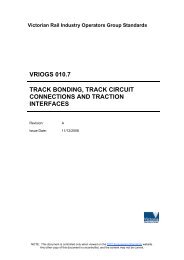VRIOGS 002.1 Railway Station Design Standard and Guidelines
VRIOGS 002.1 Railway Station Design Standard and Guidelines
VRIOGS 002.1 Railway Station Design Standard and Guidelines
You also want an ePaper? Increase the reach of your titles
YUMPU automatically turns print PDFs into web optimized ePapers that Google loves.
<strong>VRIOGS</strong> <strong>002.1</strong> Revision A 17SECTION 6.0 STATION/PLATFORM LOCATION ANDCONFIGURATION6.1 ENGINEERING DESIGN CONSIDERATIONS FOR LOCATING ASTATIONThe engineering design considerations when locating a station are outlined below:a) Top of a hill or rise on undulating terrainOn undulating terrain the ideal position for locating a station is on the level sectionat the peak of a hill or rise due to a greatly increased braking ability of a trainapproaching stations situated at the top of a rise. Situations where this is possibleare obviously limited <strong>and</strong> heavily dependent upon the existent terrain. Howeverwhere this condition is prevalent the safety benefits should be taken intoconsideration <strong>and</strong> assessed against other risks for what can be achieved throughearthworks associated to the particular location.b) On Tangent of TrackA station <strong>and</strong> its associated platforms shall be located on straight sections of track<strong>and</strong> be constructed with straight platform edges where possible. This alleviates theneed for Single Person Operated Trains (SPOT) Closed Circuit Television (CCTV)<strong>and</strong> platform mirrors as well as keeping stepping distances <strong>and</strong> heights to aminimum.Deviation from this requirement (for example where there are topography or builtenvironment constraints) would require acceptance by the ARO who will assesseach situation on its merits <strong>and</strong> determine whether the deviation can beincorporated in its safe working system.Where alterations are made to existing curved platforms, all endeavours should bemade to achieve straight platform edges. Clearances for curved platforms areoutlined in Appendix C.c) Away from Level CrossingsAs per VRIOG <strong>St<strong>and</strong>ard</strong> 012.0 ‘Victorian Signalling Principles’, there shall be a 20metre minimum, horizontal separation between the end of a platform <strong>and</strong> thecorresponding signal. There should (where practical) be an additional 200m metreshorizontal separation between the corresponding signal <strong>and</strong> to any adjacent levelcrossing. Where this cannot be achieved then the signal shall not be less then 20metres from a level crossing. This is shown diagrammatically in Figure 1:Separation between platform <strong>and</strong> level crossing Separation between platform <strong>and</strong>level crossing on the following page. These distances should allow for any potentialextensions to meet the future platform requirements as described in Section 18.2.For further track engineering design requirements at platforms refer to Section18.1.NOTE: This document is controlled only when viewed on the DOT Engineering <strong>St<strong>and</strong>ard</strong>s website. Any othercopy of this document is uncontrolled, <strong>and</strong> the content may be inaccurate.

















